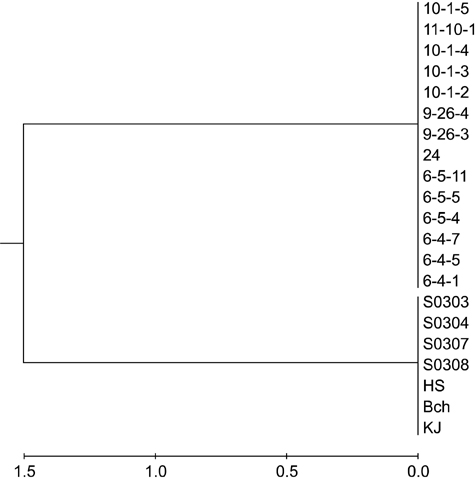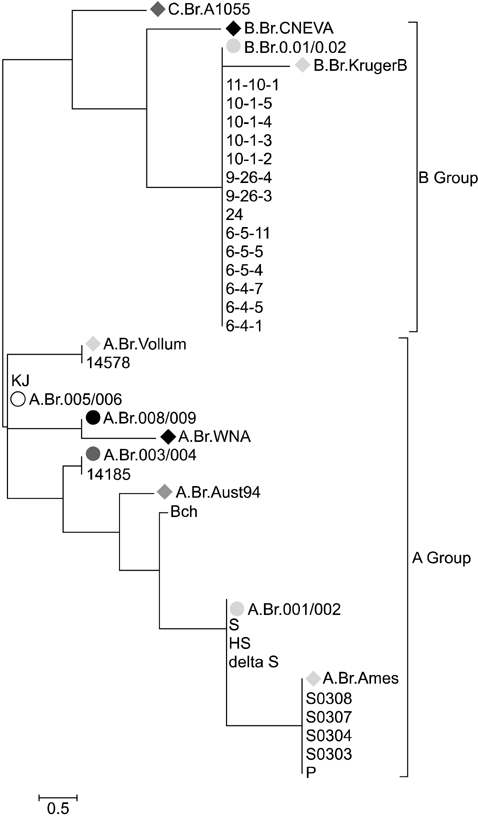J Vet Sci.
2012 Dec;13(4):385-393.
Genetic populations of Bacillus anthracis isolates from Korea
- Affiliations
-
- 1Institute of Natural Science and Technology, Hanyang University, Ansan 426-791, Korea.
- 2Division of Molecular and Life Sciences, Hanyang University, Ansan 426-791, Korea. ygchai@hanyang.ac.kr
- 3Department of Bacteriology, National Institute of Health, Cheongwon 363-951, Korea.
Abstract
- Bacillus (B.) anthracis is the pathogen that causes fatal anthrax. Strain-specific detection of this bacterium using molecular approaches has enhanced our knowledge of microbial population genetics. In the present study, we employed molecular approaches including multiple-locus variable-number tandem repeat analysis (MLVA) and canonical single-nucleotide polymorphism (canSNP) analysis to perform molecular typing of B. anthracis strains isolated in Korea. According to the MLVA, 17 B. anthracis isolates were classified into A3a, A3b, and B1 clusters. The canSNP analyses subdivided the B. anthracis isolates into two of the three previously recognized major lineages (A and B). B. anthracis isolates from Korea were found to belong to four canSNP sub-groups (B.Br.001/2, A.Br.005/006, A.Br.001/002, and A.Br.Ames). The A.Br.001/002 and A.Br.Ames sub-lineages are closely related genotypes frequently found in central Asia and most isolates were. On the other hand, B. anthracis CH isolates were analyzed that belonged to the B.Br.001/002 sub-group which found in southern Africa, Europe and California (USA). B.Br.001/002 genotype is new lineage of B. anthracis in Korea that was not found before. This discovery will be helpful for the creation of marker systems and might be the result of human activity through the development of agriculture and increased international trade in Korea.
Keyword
MeSH Terms
Figure
Reference
-
1. Achtman M. Evolution, population structure, and phylogeography of genetically monomorphic bacterial pathogens. Annu Rev Microbiol. 2008. 62:53–70.
Article2. Andersen GL, Simchock JM, Wilson KH. Identification of a region of genetic variability among Bacillus anthracis strains and related species. J Bacteriol. 1996. 178:377–384.
Article3. Beyer W, Turnbull PCB. Anthrax in animals. Mol Aspects Med. 2009. 30:481–489.
Article4. Fasanella A, Losito S, Adone R, Ciuchini F, Trotta T, Altamura SA, Chiocco D, Ippolito G. PCR assay to detect Bacillus anthracis spores in heat-treated specimens. J Clin Microbiol. 2003. 41:896–899.
Article5. Fouet A, Smith KL, Keys C, Vaissaire J, Le Doujet C, Lévy M, Mock M, Keim P. Diversity among French Bacillus anthracis isolates. J Clin Microbiol. 2002. 40:4732–4734.
Article6. Gierczyński R, Kałużewski S, Rakin A, Jagielski M, Zasada A, Jakubczak A, Borkowska-Opacka B, Rastawicki W. Intriguing diversity of Bacillus anthracis in eastern Poland--the molecular echoes of the past outbreaks. FEMS Microbiol Lett. 2004. 239:235–240.7. Hoffmaster AR, Fitzgerald CC, Ribot E, Mayer LW, Popovic T. Molecular subtyping of Bacillus anthracis and the 2001 bioterrorism-associated anthrax outbreak, United States. Emerg Infect Dis. 2002. 8:1111–1116.
Article8. Hunter IS. Glover DM, editor. Gene cloning in Streptomyces. DNA Cloning: a Practical Approach. 1985. Vol. 2. Washington, DC: IRL Press;19–44.9. Jung KH, Seo GM, Yoon JW, Park KS, Kim JC, Kim SJ, Oh KG, Lee JH, Chai YG. Protein expression pattern of murine macrophages treated with anthrax lethal toxin. Biochim Biophys Acta. 2008. 1784:1501–1506.
Article10. Kassen R, Llewellyn M, Rainey PB. Ecological constraints on diversification in a model adaptive radiation. Nature. 2004. 431:984–988.
Article11. Keim P, Gruendike JM, Klevytska AM, Schupp JM, Challacombe J, Okinaka R. The genome and variation of Bacillus anthracis. Mol Aspects Med. 2009. 30:397–405.12. Keim P, Kalif A, Schupp J, Hill K, Travis SE, Richmond K, Adair DM, Hugh-Jones M, Kuske CR, Jackson P. Molecular evolution and diversity in Bacillus anthracis as detected by amplified fragment length polymorphism markers. J Bacteriol. 1997. 179:818–824.
Article13. Keim P, Klevytska AM, Price LB, Schupp JM, Zinser G, Smith KL, Hugh-Jones ME, Okinaka R, Hill KK, Jackson PJ. Molecular diversity in Bacillus anthracis. J Appl Microbiol. 1999. 87:215–217.14. Keim P, Price LB, Klevytska AM, Smith KL, Schupp JM, Okinaka R, Jackson PJ, Hugh-Jones ME. Multiple-locus variable-number tandem repeat analysis reveals genetic relationships within Bacillus anthracis. J Bacteriol. 2000. 182:2928–2936.
Article15. Keim P, Van Ert MN, Pearson T, Vogler AJ, Huynh LY, Wagner DM. Anthrax molecular epidemiology and forensics: using the appropriate marker for different evolutionary scales. Infect Genet Evol. 2004. 4:205–213.
Article16. Keim PS, Wagner DM. Humans and evolutionary and ecological forces shaped the phylogeography of recently emerged diseases. Nat Rev Microbiol. 2009. 7:813–821.
Article17. Kenefic LJ, Pearson T, Okinaka RT, Chung WK, Max T, Trim CP, Beaudry JA, Schupp JM, Van Ert MN, Marston CK, Gutierrez K, Swinford AK, Hoffmaster AR, Keim P. Texas isolates closely related to Bacillus anthracis Ames. Emerg Infect Dis. 2008. 14:1494–1496.18. Kim HT, Seo GM, Jung KH, Kim SJ, Kim JC, Oh KG, Koo BS, Chai YG. Generation of a specific marker to discriminate Bacillus anthracis from other bacteria of the Bacillus cereus group. J Microbiol Biotechnol. 2007. 17:806–811.19. Kim S, Misra A. SNP genotyping: technologies and biomedical applications. Annu Rev Biomed Eng. 2007. 9:289–320.
Article20. Kolonin GV. Evolution of anthrax. II. History of the spread of the disease and formation of the nosoareal. Zh Mikrobiol Epidemiol Immunobiol. 1971. 48:118–122.21. Le Flèche P, Hauck Y, Onteniente L, Prieur A, Denoeud F, Ramisse V, Sylvestre P, Benson G, Ramisse F, Vergnaud G. A tandem repeats database for bacterial genomes: application to the genotyping of Yersinia pestis and Bacillus anthracis. BMC Microbiol. 2001. 1:2.22. Lim HS, Son YG, Yoo HS, Keun SW, Kim JW. Anthrax: an overview. Korean J Epidemiol. 2005. 27:12–25.23. Limpanawat S, Promdonkoy B, Boonserm P. The C-terminal domain of BinA is responsible for Bacillus sphaericus binary toxin BinA-BinB interaction. Curr Microbiol. 2009. 59:509–513.
Article24. Lista F, Faggioni G, Valjevac S, Ciammaruconi A, Vaissaire J, le Doujet C, Gorgé O, De Santis R, Carattoli A, Ciervo A, Fasanella A, Orsini F, D'Amelio R, Pourcel C, Cassone A, Vergnaud G. Genotyping of Bacillus anthracis strains based on automated capillary 25-loci multiple locus variable-number tandem repeats analysis. BMC Microbiol. 2006. 6:33.25. Maho A, Rossano A, Hächler H, Holzer A, Schelling E, Zinsstag J, Hassane MH, Toguebaye BS, Akakpo AJ, Van Ert M, Keim P, Kenefic L, Frey J, Perreten V. Antibiotic susceptibility and molecular diversity of Bacillus anthracis strains in Chad: detection of a new phylogenetic subgroup. J Clin Microbiol. 2006. 44:3422–3425.
Article26. Maiden MCJ. Multilocus sequence typing of bacteria. Annu Rev Microbiol. 2006. 60:561–588.
Article27. Miettinen MK, Siitonen A, Heiskanen P, Haajanen H, Björkroth KJ, Korkeala HJ. Molecular epidemiology of an outbreak of febrile gastroenteritis caused by Listeria monocytogenes in cold-smoked rainbow trout. J Clin Microbiol. 1999. 37:2358–2360.
Article28. Mock M, Fouet A. Anthrax. Annu Rev Microbiol. 2001. 55:647–671.
Article29. Read TD, Salzberg SL, Pop M, Shumway M, Umayam L, Jiang L, Holtzapple E, Busch JD, Smith KL, Schupp JM, Solomon D, Keim P, Fraser CM. Comparative genome sequencing for discovery of novel polymorphisms in Bacillus anthracis. Science. 2002. 296:2028–2033.
Article30. Ryu C, Lee K, Hawng HJ, Yoo CK, Seong WK, Oh HB. Molecular characterization of Korean Bacillus anthracis isolates by amplified fragment length polymorphism analysis and multilocus variable-number tandem repeat analysis. Appl Environ Microbiol. 2005. 71:4664–4671.
Article31. Schupp JM, Klevytska AM, Zinser G, Price LB, Keim P. vrrB, a hypervariable open reading frame in Bacillus anthracis. J Bacteriol. 2000. 182:3989–3997.
Article32. Shahid S, Park JH, Lee HT, Kim SJ, Kim JC, Kim SH, Han DMR, Jeon DI, Jung KH, Chai YG. Comparative proteome analysis of Bacillus anthracis with pXO1 plasmid content. J Microbiol. 2010. 48:771–777.
Article33. Simonson TS, Okinaka RT, Wang B, Easterday WR, Huynh L, U'Ren JM, Dukerich M, Zanecki SR, Kenefic LJ, Beaudry J, Schupp JM, Pearson T, Wagner DM, Hoffmaster A, Ravel J, Keim P. Bacillus anthracis in China and its relationship to worldwide lineages. BMC Microbiol. 2009. 9:71.34. Stratilo CW, Lewis CT, Bryden L, Mulvey MR, Bader D. Single-nucleotide repeat analysis for subtyping Bacillus anthracis isolates. J Clin Microbiol. 2006. 44:777–782.
Article35. van Belkum A, Scherer S, van Alphen L, Verbrugh H. Short-sequence DNA repeats in prokaryotic genomes. Microbiol Mol Biol Rev. 1998. 62:275–293.
Article36. Van Ert MN, Easterday WR, Huynh LY, Okinaka RT, Hugh-Jones ME, Ravel J, Zanecki SR, Pearson T, Simonson TS, U'Ren JM, Kachur SM, Leadem-Dougherty RR, Rhoton SD, Zinser G, Farlow J, Coker PR, Smith KL, Wang B, Kenefic LJ, Fraser-Liggett CM, Wagner DM, Keim P. Global genetic population structure of Bacillus anthracis. PLoS One. 2007. 2:e461.37. Van Ert MN, Easterday WR, Simonson TS, U'Ren JM, Pearson T, Kenefic LJ, Busch JD, Huynh LY, Dukerich M, Trim CB, Beaudry J, Welty-Bernard A, Read T, Fraser CM, Ravel J, Keim P. Strain-specific single-nucleotide polymorphism assays for the Bacillus anthracis Ames strain. J Clin Microbiol. 2007. 45:47–53.
Article
- Full Text Links
- Actions
-
Cited
- CITED
-
- Close
- Share
- Similar articles
-
- Genetic Diversity among Virulent Mega Plasmids pXO1 and pXO2 of Bacillus anthracis Isolated in Korea
- Important cultural and biological properties of virulent and attenuated vaccine strains of bacillus anthracis for differentation from other closely related bacillus species
- Differentiation of attenuated vaccine strains, pasteur no. 2-army and sterne 34-F2 of bacillus anthracis from other bacillus species by surface and subsurface giant colony morphology
- Molecular Evolution and Identification of Bacillus anthracis Isolated from Korea by Variable Number Tandem Repeat Analysis
- Evaluation of gyrB as Chromosomal Marker in Bacillus anthracis




